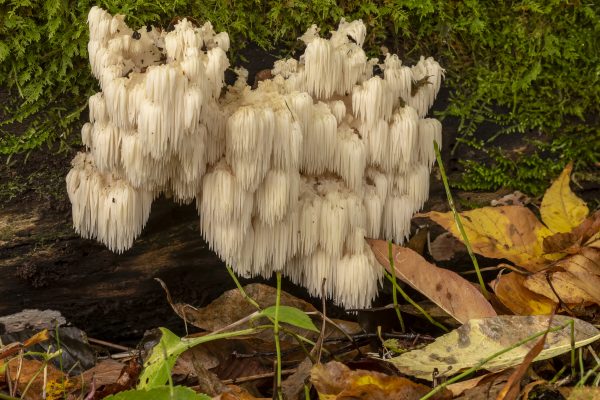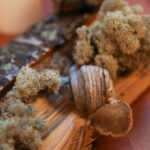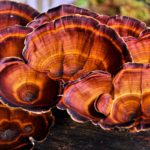Lion's Mane Mushrooms For Nerve Damage?
I was diagnosed with transverse myelitis a few months ago. It affects the strength in my left leg. I’ve read that you suggested Lion’s Mane mushroom to help with nerve growth. Would it be helpful to me? I am also doing acupuncture and have adopted an anti-inflammatory diet. If it is appropriate for me to take Lion’s Mane, can I do so while breastfeeding?
Andrew Weil, M.D. | January 31, 2022

Transverse myelitis (TM) is a neurological disorder that stems from inflammation across a segment of the spinal cord. The inflammation can damage or destroy myelin, the fatty substance that insulates nerve cell fibers. Lion’s mane mushroom (Hericium erinaceus) is a nontoxic medicinal (and culinary) mushroom believed to stimulate nerve growth. It has not specifically been shown to affect the symptoms of TM, but it is nontoxic and completely safe, so I see no problem with your using it, even while breastfeeding.
Transverse myelitis (TM) typically affects younger people. Peak incidence is among those between the ages of 10 and 19 and 30 and 39. The cause is unknown but may be a viral infection, an abnormal immune system reaction or insufficient blood flow through the blood vessels in the spinal cord. TM can also develop as a complication of measles, syphilis, Lyme disease, and rarely after vaccinations for chickenpox and rabies.
Symptoms of TM include muscle weakness or paralysis, usually beginning in the legs and sometimes affecting the arms, as well. Abnormal sensation, including pain and diminished ability to feel changes in temperature, occurs below the level of the spinal cord inflammation. Many of those affected describe the feeling of a tight band or girdle around the trunk. This area may also be sensitive to touch.
About one-third of all patients recover fully; another third may be left with some deficiencies in their walking gait, urinary urgency or incontinence, and some sensory loss. Unfortunately, the other third do not improve at all. Treatment focuses on maintaining body functions via physical therapy, as well as occupational and vocational therapy. Conventional medicine treats the earliest stages of the disorder with corticosteroids for about five days or longer in an effort to reduce the inflammation and increase chances of a speedy recovery. If this doesn’t help, other drug treatments may be used in an attempt to salvage neurological function. Pain killers may also be prescribed. Bed rest often is recommended during the early days and weeks of the disorder.
Following initial therapy, the most critical part of the treatment consists of keeping the patient’s body functioning while hoping for either complete or partial spontaneous recovery of the nervous system. This is usually done in a hospital or a rehabilitation facility where a specialized medical team can prevent or treat problems that may occur. Often, even before recovery begins, caregivers may be instructed to move patients’ limbs manually to help keep the muscles flexible and strong and to reduce the likelihood of pressure sores. Later, if patients begin to recover limb control, physical therapy can help improve muscle strength, coordination, and range of motion.
While there haven’t been a lot of scientific studies on how lion’s mane works, an animal study published in 2012 suggested that it is useful in nerve repair. Erinacine A, one of the active compounds in lion’s mane, has been shown to be beneficial to nerve cells in rats, and there may be potential for pharmaceutical development of erinacine A-enriched lion’s mane. For now, know that lion’s mane may have some beneficial effects in nerve repair and it’s nontoxic and completely safe, so there is no harm in using it.
Andrew Weil, M.D.
Learn more: All About Mushrooms
Sources:
M.A. Khan, M. Tania, M.M. Rahman “Hericium erinaceus: an edible mushroom with medicinal values.” Journal of Complementary Integrative Medicine, doi: 10.1515/jcim-2013-0001. https://pubmed.ncbi.nlm.nih.gov/23735479/
K.H. Wong, et al, “Neuroregenerative potential of lion’s mane mushroom, Hericium erinaceus (Bull.: Fr.) Pers. (higher Basidiomycetes), in the treatment of peripheral nerve injury (review)” International Journal of Medicinal Mushrooms. 2012;14(5):427-46. http://www.ncbi.nlm.nih.gov/pubmed/23510212
Li IC, Lee LY, Tzeng TT, Chen WP, Chen YP, Shiao YJ, Chen CC. “Neurohealth Properties of Hericium erinaceus Mycelia Enriched with Erinacines.” Behav Neurol. 2018 May 21;2018:5802634. doi: 10.1155/2018/5802634. PMID: 29951133; PMCID: PMC5987239. https://pubmed.ncbi.nlm.nih.gov/29951133/
Shimbo M., Kawagishi H., Yokogoshi H. “Erinacine A increases catecholamine and nerve growth factor content in the central nervous system of rats.” Nutrition Research. 2005;25(6):617–623. doi: 10.1016/j.nutres.2005.06.001. https://www.sciencedirect.com/science/article/pii/S0271531705001041
Originally Published February 2014. Updated January 2022.












